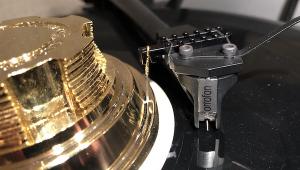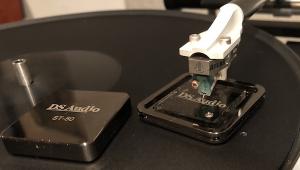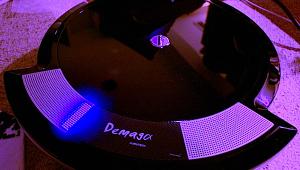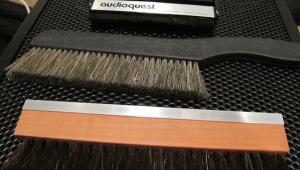Yes, it's true. I got it from the designer himself. The motor used with my VPI Scoutmaster is 7 watts and runs the psu very hot. I hope they come up with a design that is able to handle the 300 rpm motor from VPI.
Phoenix Engineering's Falcon PSU and Roadrunner Tachometer
The PSU works with 115/120V A.C. motors as well as with lower voltage ones by plugging into it the voltage step-down wall adapter transformer. It won’t work with D.C. motor-equipped ‘tables or those that have internal A.C. power supplies unless they are bypassed.
While the Falcon’s functionality is similar to those of “speed boxes” with which you might be familiar, its resolution, using DDS (Direct Digital Synthesis) technology is claimed to be far greater than those using Pulse Width Modulation (PWM) technology, which, according to Phoenix Engineering includes among others those from Pro-Ject and Music Hall.
For those who don’t understand much or any of this, an A.C. synchronous motor syncs its speed to the 60 cycle frequency of the alternating current coming from your wall socket (which is why it is called an “A.C. synchronous” motor in the first place). Unfortunately, for various reasons, your utility company doesn’t necessarily provide at all times a consistent and stable 60Hz alternating current or for that matter, 115 volts.
Outboard motor controllers from Pro-Ject, Music Hall (produced by Pro-Ject for Music Hall) VPI and others, take the turntable’s motor "off line" by synthesizing, usually via a quartz controlled oscillator, a more stable and consistent 60Hz, 115 volt A.C. signal that more accurately drives the motor, resulting in greater platter speed accuracy. What’s more, varying the synthesized frequency allows the motor speed to be precisely varied to produce correct speed even if the ‘table runs at the incorrect speed plugged directly into the wall. In addition, playback of records incorrectly mastered in the first place (for example The Rolling Stones’s Beggar’s Banquet can be played back at the correct speed.
While conceptually this sounds straight forward, in practice producing a high resolution microprocessor-controlled 60Hz output frequency is considerably more complex. If your eyes are now glazing over you can skip the next few paragraphs.
According to Phoenix Engineering, the resolution of a Pulse Width Modulated generated tone is analogous to an 8 bit DAC. The rate of change (the frequency output) must be updated 256 times faster than the output waveform so that even with a 16 bit timer, the frequency resolution is 1/256 or ~0.4%. At 60 Hz (the output frequency for 45 RPM control on the Music Hall/Pro-Ject motor controller), the frequency resolution is equivalent to ±0.24 Hz.
The Falcon PSU’s clock frequency is 9320Hz, while the DDS accumulator is 28 bits, resulting in a frequency resolution equivalent to 35µHz (0.000035 Hz) or roughly 7000 times finer than that generated by PWM. The Falcon PSU’s 10 bit DAC develops the outputted sine wave, resulting in noise and distortion that’s approximately 4 times lower than that of an 8 bit PWM generated sine wave.
When used in conjunction with the RoadRunner tachometer, speed compensation can be accomplished slowly and evenly throughout the next platter revolution in approximately 0.0005RPM inaudible “baby” steps.
According to Phoenix Engineering, other regenerative power supplies create 115V A.C. with a low voltage amplifier that boosts microprocessor output to drive a small, high output impedance step up transformer. While this produces the required 120 volts, the voltage will drop considerably (to around 95 volts) under the motor’s load. According to Phoenix Engineering, as the load increases so does noise and distortion.
The Falcon PSU’s built-in high voltage dual polarity DC supply produces ± 175 D.C. volts that supplies a high voltage, directly coupled amplifier with ample feedback to keep the output impedance extremely low. The resulting 115 volt A.C. output wave does not drop significantly when loaded by the motor and there are no transformers or coupling caps in the output path.
For reasons even more complicated than what’s above (so for our purposes we’ll skip the details), because of how they are designed and implemented, the Pro-Ject and Music Hall “speed boxes” produce greater motor cogging at 33 1/3 than they do at 45rpm. The Falcon PSU outputs 60Hz at 33 1/3 and 81Hz at 45 rpm, thus producing optimal phase shift at 33 1/3, which is the speed of most LPs. Even at 45, while not as optimal as at 33 1/3, because of the higher speed, cogging is almost non-existent. Another feature of the Falcon PSU is its ability to be front panel programmable for 50/60Hz operation so that if you have a turntable from overseas designed to work at 50Hz, it can be made to work here without changing the pulley.
Like VPI’s SDS the Falcon’s output voltage drops to a pre-set lower value once the platter reaches the proper speed, which results in less motor vibration (the actual lower voltage can also be user set) . In addition, upon turn on, the Falcon evenly ramps up to either 33 1/3 or 45rpm, which reduces “belt burn out” caused by belt slippage. From the PSU’s front panel, one can select 33 1/3 and 45rpm operation while a calibration mode allows adjustment in ±0.01 RPM steps.
Connecting and Using the Falcon PSU
Because it is remarkably compact (3.5”x2.5”x1.18” appx.), there’s insufficient room for an A.C. jack on the Falcon PSU’s extruded aluminum back panel into which to plug your turntable. Instead, extending from the back panel is a hard wired A.C. cord fitted with an A.C. jack. You plug your ‘table’s A.C. plug into it and the PSU’s “wall wart” plug into your wall socket.
I auditioned the Falcon PSU first with the recently reviewed Avid Ingenium turntable, a “budget” model featuring no motor supply, that plugs the A.C. synchronous motor directly into the wall.
Instead I plugged it into the Falcon PSU, pushed the “stby” (standby) button and the platter began spinning and “ramped” up to 33.3rpm. At the push of the same button the speed increased to 45rpm with me not having to remove the platter to change belt position on the motor pulley as would be the case without the Falcon Digital PSU.
But of course that the display reads either 33.3 or 45 does not mean the platter is spinning at that speed. In order to determine the actual platter speed, you need a strobe disc of some sort.
Should you determine the actual platter speed to be either fast or slow, you enter “frequency calibration” mode from “standby” mode by holding the “Plus” button and pressing and releasing the “stby” button. The display shows “CAL”. Pushing the “Plus” or “Minus” buttons will change the speed in 0.01RPM increments. Holding either one down increases or decreases the speed at a rate of 8 times (0.01RPM) per second.
Once you’ve achieved the correct speed for both 33.33 and 45rpm, pressing and holding the “stby” button displays “SAV”, which saves the settings in non-volatile memory. Returning to the factory default mode is simple: pull the plug, press and hold both “plus” and “Minus” buttons while re-inserting the plug.
Adding the Roadrunner Digital Tachometer
Using a hall effect sensor (if you’re unfamiliar do a websearch!) and small magnet, the $234 Roadrunner Digital Tachometer monitors actual platter speed to 3 decimal points of resolution via a temperature compensate crystal oscillator accurate to 2.5PPM (±0.00025%) with less than 1.0PPM aging per year (we should all do as well !).
You can use the PSU without the Roadrunner or the Roadrunner without the PSU. You can also use both but not connected together. For many with high performance turntables that incorporate built in motor controllers, adding the Roadrunner makes easy precise speed monitoring.
The Roadrunner Digital Tachometer includes a hall effect sensor mounted on a small PCB (printed circuit board). Both it and the included tiny disc magnet have adhesive backings. In order for the system to work, the magnet must come in close proximity to the hall effect sensor.
In the ideal situation, there would be sufficient plinth-to-platter-bottom clearance for the PCB to fit comfortably in-between and for the magnet to be attached to the bottom of the platter without the two elements touching each other when the platter spins. In addition you have to be careful about the magnet’s clearance at all points in the platter’s spin.
Adding to the system’s set-up complexity is that the magnet must pass directly over the hall effect sensor and in very close proximity to it— with the two elements almost, but not quite touching.
For some turntables set-up will be simple. Others, either those with minimal or no platter/plinth clearance, or those with minimal plinths will require a bit of ingenuity. The Ingenium, with its “I” beam plinth presented a number of challenges. There was no plinth to which to attach the PCB so I constructed a platform in order to raise the sensor close to the platter bottom. Once I’d accomplished that, I affixed the magnet to the platter bottom and figured “mission accomplished”.
Unfortunately, I didn’t realize that the platter/plinth clearance was not identical at all points. No problem on the left side of the “I” beam but clearance was smaller between the platter bottom and the side where the arm attaches, so when I rotated the platter I heard and felt rubbing. Back to the drawing board (by the way: did you know that the term “back to the drawing board” first appeared in a 1941 New Yorker cartoon?)!
I realized that while I couldn’t affix the magnet to the platter bottom, I could affix it to the platter side and avoid clearance issues. That required re-orienting to vertical the hall sensor chip platform but once accomplished, the magnet/sensor chip proximity seemed satisfactory.
The Roadrunner instructions provide a test for this. But first you have to plug one end of a supplied cable into the sensor PCB jack and the other into the back of the sensor. Then, to power the tachometer you plug another cable between it and the PSU. When powered up by pushing a back panel mounted button, five dashes will appear on the Roadrunner screen. You then rotate the platter by hand to line up the magnet and the hall sensor. If all is good, a sixth dash will light. If it doesn’t, you have to improve the alignment until it does. You’ll find the distance between the magnet and sensor very “tight”.
At that point you can’t wait to try this all out! Turn on the motor from the Falcon PSU and within two revolutions the Roadrunner’s LED screen will give you the platter speed, updating it every revolution after that. More importantly, once per rotation the tachometer will then output to the Falcon PSU the actual platter speed. The PSU will then compare the actual platter speed to its speed setting (33.3/45) and automatically lock the turntable speed to within ±0.005 RPM. Whatever adjustments might be necessary to achieve speed perfection are accomplished slowly and evenly over the next revolution. The result is correct speed regardless of belt tension issues (common to outboard motor systems such as the Ingenium’s) bearing oil viscosity, stylus drag or other variables.
This system’s resolution is such that the “hunting and pecking” for the correct speed common to 70’s and 80’s era phase locked loop turntables is here a non-issue, though it’s fair to say that “perfection” is probably an overstatement for this system or any basic hall sensor control system, the most sophisticated of which use multiple sensors arrayed around the platter’s rotation In addition, it should be pointed out that grossly out of round platters or sub-platters or pulleys would probably be beyond the capabilities of this (or any such system) to fully and adequately compensate.
A Major Sonic Upgrade!
Used with the Avid Ingenium turntable, the sonic improvement wrought by the combination of Falcon PSU and Roadrunner Tachometer was not subtle. In fact, it spelled the difference between a turntable that plugged directly into the wall was unsatisfactory for piano music or any music that features long instrumental sustains and one that was more than satisfactory reproducing such music (assuming the records themselves were not pressed eccentrically).
Adding Phoenix Engineering’s Falcon PSU and Roadrunner Tachometer to the Avid Ingenium produced sonic benefits well beyond eliminating gross audible “wow”. Bass tightened up significantly, the rhythm’n’pacing of all musical genres improved as did attack precision. These differences were not subtle. It was almost like substituting a new turntable.
Yes, it added $613 to the turntable’s cost but I think the improvement was well worth the money and should you later choose to upgrade, the two pieces could migrate to the next ‘table, should you buy one with an A.C. synchronous motor. Phoenix Engineering sells additional magnets and hall sensor PCBs
These are easy to recommend products. I don’t know if they come with a money back guaranty but they should. I would find it difficult to believe that anyone buying and trying would want to return either the PSU or the Roadrunner and especially not both. Highly recommended! Currently available at (among other dealers): The Cable Company, Honolulu, HI based Audio Directions Limited, Hi-Fi Heaven and Bob’s Devices Inc.. For more information, videos FAQs and a complete dealer list, visit Phoenix Engineering's website.
- Log in or register to post comments


The original 600 RPM motor used by VPI was a special version of the Hurst 7.5W motor wound for 5.5W. For some reason when they sourced the 300 RPM motor, they did not do a special version so the power requirement remains 7.5W.
We are in the process of sourcing a footprint compatible 5W 300 RPM motor that will work in many of the VPI applications. We have samples of the motors and are still working on the pulleys. We hope to have this all sorted out by next month.

When you say you are "sourcing a footprint compatible 5W 300 rpm motor," are you saying that your company would take my current motor on trade for the 5W 300rpm motor, thereby allowing the PSU to work properly? Or are you saying that potential customers like myself would have to "purchase" the new motor from you prior to buying the PSU and Roadrunner, thereby adding a significant cost to my purchase?

Could the magnet be recessed into the bottom of the platter and the circuit board be mounted to the left side of the I beam?

And love it. My TT was pretty solid tonally before, but now it's just locked in. Solo piano sounds so effortless now, and anything with a beat cooks right along. Everything I listen to has more nuance to it. I use only the PSU and set it with a KAB strobe, and it has not drifted really at all. Not affiliated with the Phoenix Engineering in any way, just a happy customer.

Am I correct to say that this new motor controller will not work with my VPI Classic 1?

It depends. The newest Classic 1 has a built in controller and an external DC power supply that would not be compatible. If it is one of the older Classic 1s, you would need to ensure the motor is 5.5W or less by looking at the label on the motor itself, or contacting the dealer or VPI. If it has the 300 RPM pulley (~1.2" diameter 33 RPM spindle) it is almost certainly the 7.5W motor which would need to be changed out.

It sounds incompatible since the Classic 3 takes an IEC power cord terminal directly. Am I right?

Subject to the same restrictions above, it would be compatible. You would either plug the motor's AC cord into the Falcon output, or it can be ordered with an IEC C13 socket (instead of the NEMA 5-15) that would plug directly into the motor.

Does that mean anything to anyone? Is this a 7 or a 5 watt motor unit?


The Traveler has a built in supply, so no, it wouldn't work.

One of the advertising slogans used by Vpi for the Classic series is "speed stability on par with the master tape". If this being true, what benefit does these two units offer? Seems kinda redundant, maybe i am missing something?

Please what non-VPI unit(s) does work with the Classic 3?
Thanks for any comment on experience(s) too :-)

Would buy the Falcon PSU and roadrunner straight away. I tried once something similar on my Thorens TD 124 and was quite impressed. Sadly the TD 124 motor needs at least 15 W. I could buy 4 Falcons and connect them parallel to the motor...

I have a '96 VPI HW-19 (Mk3=>Mk4), with probably the Hurst motor that Bill describes (5.5w pull?). The Falcon runs hot, but I'm told that it runs within spec.
The Falcon/RR duo is a great setup for this deck. I'm seeing constant speeds of between 33.331 and 33.337 once things get warmed up. Typically 33.33[3-5].

This is a great PSU for all reasons described above. But I also want to mention how good the people at Phoenix Engineering were to work with. A few days after I bought my unit from Hi-Fi Heaven I broke it doing something stupid with a voltage transformer and old Telefunken turntable. Bill at Phoenix was extremely good-humored about it. He repaired it quickly, offered some helpful advice, and had it back to me in less than a week and a half.
Now I have it hooked up to a stripped-down Elite Rock II and couldn't be happier.

















































